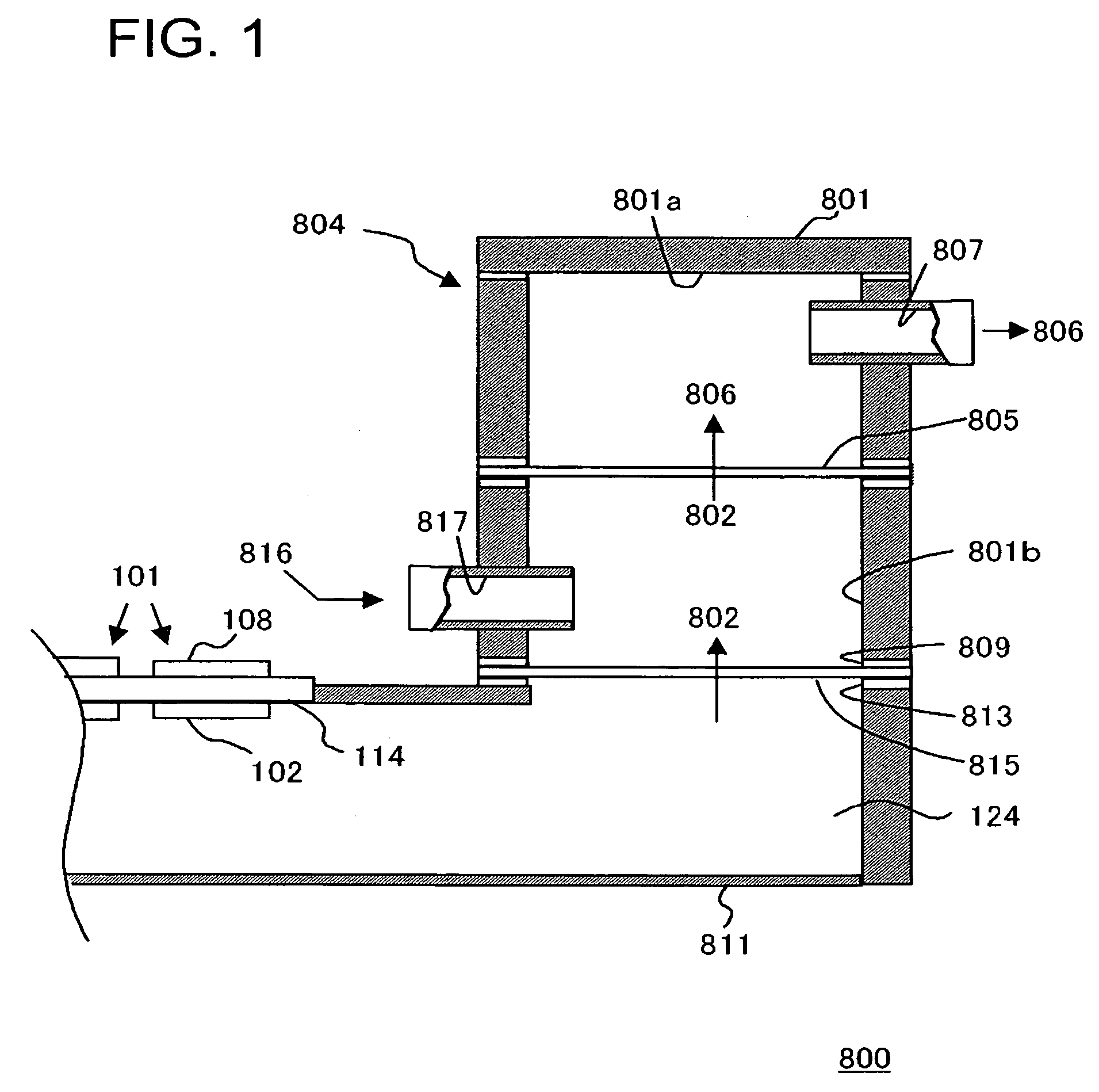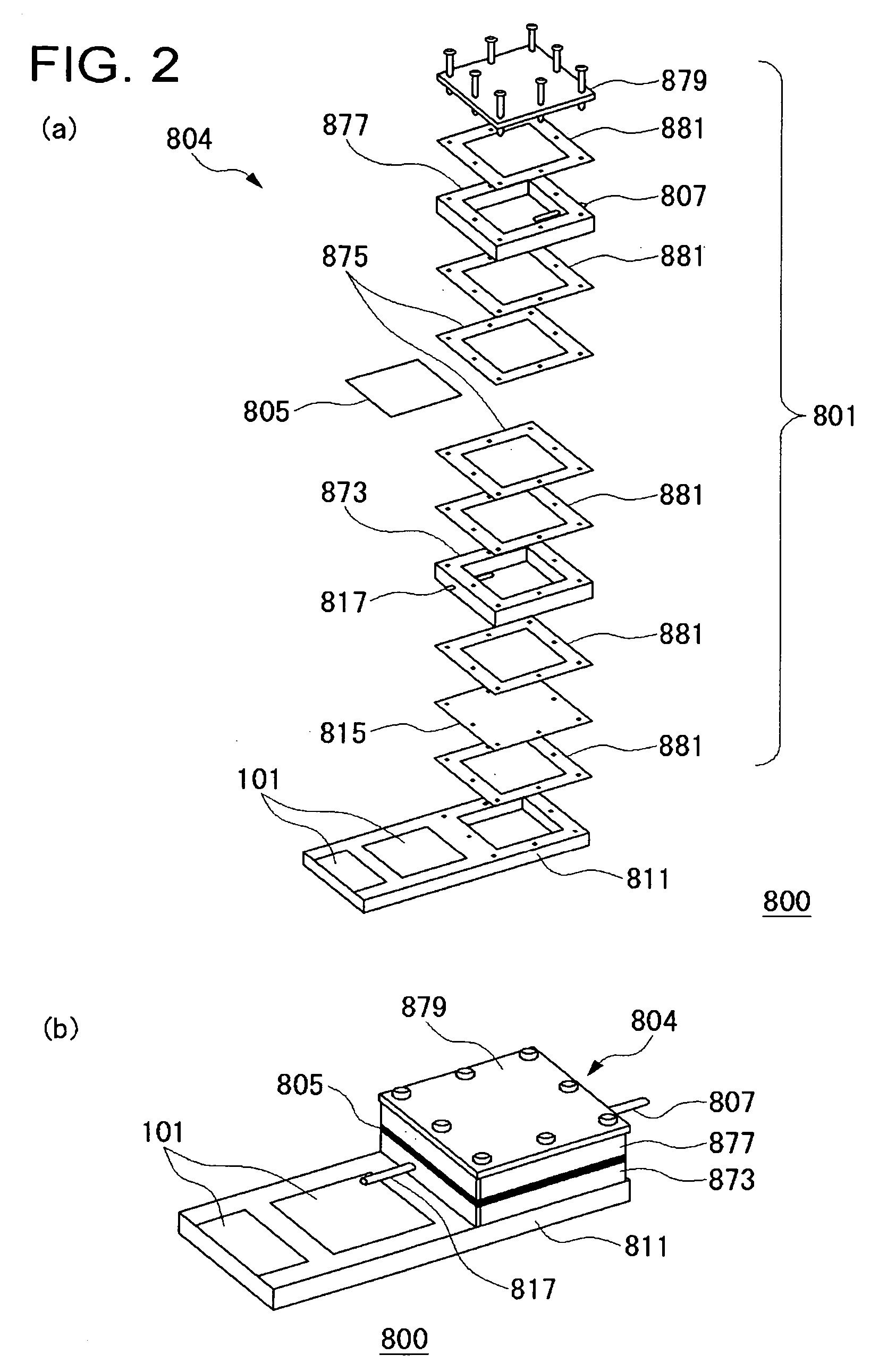Fuel cell system, fuel cell operation method, and gas treatment device
- Summary
- Abstract
- Description
- Claims
- Application Information
AI Technical Summary
Benefits of technology
Problems solved by technology
Method used
Image
Examples
first embodiment
[0044]FIG. 1 is a schematic sectional view illustrating the structure of a fuel cell system in an embodiment of the present invention.
[0045] The fuel cell system 800 includes a plurality of unit cells 101 of a fuel cell and a gas treatment unit 804 treating the gas discharged from these unit cells 101.
[0046] Each of the unit cells 101 includes a fuel electrode 102 and an oxidant electrode 108 as well as a solid electrolyte membrane 114 placed between them, and a fuel 124 is supplied to the fuel electrode 102 and an oxidant to the oxidant electrode 108, generating electricity in an electrochemical reaction. The unit cell 101 is a direct type fuel cell in which a liquid fuel is supplied to the fuel electrode 102. For example of the fuel 124 may include organic liquid fuels such as methanol, ethanol, dimethyl ether, other alcohol, or liquid hydrocarbon such as cycloparaffin or the like. The organic liquid fuel may be an aqueous solution. Normally, air is used as the oxidant, but an o...
second embodiment
[0064]FIG. 3 is a schematic sectional view illustrating a structure of a fuel cell system in an embodiment of the present invention.
[0065] The fuel cell system 820 in the present embodiment is different from the fuel cell system 800 in the embodiment above, in that a gas treatment unit 824 is formed to each unit cell 101 of the fuel cell.
[0066] In the system, the gas treatment unit 824 is formed in the upper region of the unit cell 101. The unit cell 101 is placed close to an opening 813 of the fuel container 811, and a gas-liquid separation membrane 815 is placed over a hole 823 formed in the solid electrolyte membrane 114 of the unit cell 101. In such a configuration, it is not necessary to make a region for the gas treatment unit 824 available, separately from the region for the unit cell 101, and to make the fuel cell system compact and reduce the size of the entire system.
third embodiment
[0067]FIG. 4 is a schematic sectional view illustrating a structure of a fuel cell system in an embodiment of the present invention.
[0068] The fuel cell system 830 in the present embodiment is different from those in the first and second embodiments in its shape of the catalyst. The fuel cell system 830 contains a catalyst 835 in the shape of wire wool. The catalyst 835 is filled in the exhaust vent 807 placed at the top of an outlet passage 831.
[0069] In the present embodiment, the wire wool-shaped catalyst 835 may be made of a metal, an alloy, or the oxide thereof similar to that contained in the catalyst layer 805 described in the first embodiment.
[0070] Although not shown in the Figure, the outlet passage 831 may have a configuration having an oxygen inlet 817 for supplying the oxygen 816, similarly to those described with reference to FIGS. 1 and 3 in the first and second embodiments; and oxygen 816 may be supplied from an oxygen-supplying unit not shown in the Figure.
[0071...
PUM
 Login to View More
Login to View More Abstract
Description
Claims
Application Information
 Login to View More
Login to View More - R&D
- Intellectual Property
- Life Sciences
- Materials
- Tech Scout
- Unparalleled Data Quality
- Higher Quality Content
- 60% Fewer Hallucinations
Browse by: Latest US Patents, China's latest patents, Technical Efficacy Thesaurus, Application Domain, Technology Topic, Popular Technical Reports.
© 2025 PatSnap. All rights reserved.Legal|Privacy policy|Modern Slavery Act Transparency Statement|Sitemap|About US| Contact US: help@patsnap.com



